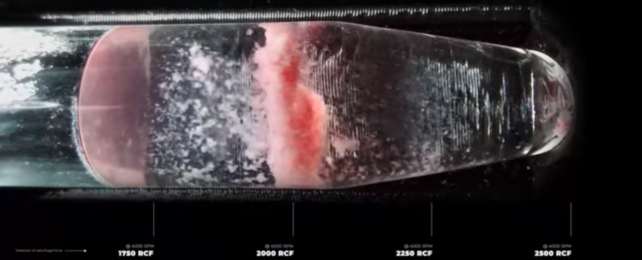A lab technician-turned-scientific photographer has created a camera that allows us to peer inside the black box of a centrifuge as it spins the heck out of its samples.
The videos are mesmerizing, and even more importantly, they show us fluid dynamics in a level of detail we've never seen before.
So far, Dutch inventor Maurice Mikkers has turned his camera on familiar fluids like coffee, smoothies, and hot sauce. But the centrifuge camera could have all kinds of research applications, from the study of physics and genetics, to food, waste-water treatment, and more.

Before pursuing scientific photography, Mikkers worked as a lab technician at the Dutch National Institute for Public Health and the Environment, where he was involved with parasite diagnostics.
There, Mikkers used a centrifuge countless times, but what went on inside the machine remained a black box mystery, one which the photographer in him always wanted to peer into.
"Whilst working at the lab, I simply had only visual knowledge of the 'pre-centrifuge' sample and the 'post-centrifuge' sample," Mikkers writes in an essay published to Medium.
He knew what the process involved in theory, from scientific illustrations and animations: "However, a live view of the separating process I have never seen included," he explains.
To capture this himself, Mikkers tinkered for months, battling through the technical problems that arise when you try to mount a digital camera on a machine spinning so fast it produces forces 2,500 times stronger than Earth's surface gravity – which of course affects not only the sample being filmed, but also the recording equipment itself.
Centrifuges work by spinning fluids at a speed that creates intense centrifugal forces. The layers furthest from the middle of the centrifuge experience more extreme centrifugal force than those closer to the middle, because the circle they're making in one rotation is much bigger.
This affects particles in the fluid differently, depending on their density, causing the components to separate into neat layers, with the most dense matter being pulled to the outermost point.

This technology is especially known for being used to separate a blood sample into red blood cells, white blood cells, platelets, and plasma, either for analysis or donation.
It's also used to extract DNA from cells. Because DNA has a lower density than other cell components, it rises to the top in a centrifuge.
This seemingly simple technique is fundamental to pretty much all genetic analysis and research, from mapping the genomes of species to detecting viruses, parasites, and bacteria in the human body, to pinpointing and even tweaking the codes that define our physical traits.
Some fluids caught on Mikkers' camera don't separate, but show interesting fluid dynamics that couldn't previously be observed in this way.
For instance, a before-and-after shot offers no hint of the mesmerizing swirls of a shower gel exposed to 2500 g-force.

Centrifuges have even been integrated into food science, with Mikkers' videos piquing the interest of Alvaro Martin, a fluid physicist from the University of Twente in the Netherlands, who discussed the footage in a presentation on culinary fluid dynamics.
"The footage from the centrifuge camera is surprising for any fluid dynamicists due to the amount of motion present in most videos, far from a gentle separation motion and persistent for minutes," Martin says.
So, getting to see what's actually going on inside that tiny spin cycle is a pretty big deal for researchers in all kinds of fields – genetics, physics, art, and even wastewater treatment.
Mikkers is currently collaborating with rheologist Lorenzo Botto from Delft University of Technology in the Netherlands, on a project they call 'Sludgecam', which explores this technology's potential application in recovering valuable resources from wastewater sludge.
When water is removed from sewage, what's left over is a disgusting, smelly and hazardous sludge that's increasingly being recognised as a 'gold mine' of nutrients and minerals, not to mention synthetic materials like polymers.
The project aims to create a smart centrifuge camera to help operators of waste-water treatment plants adapt how they treat sludge based on what's actually in it.
"It is the first time that researchers can see what happens inside a lab-scale centrifuge while it is spinning, and this will give many insights that can be applied not only to waste-water treatment, but also to other applications such as biotechnology and food processing," Botto says.
We can't wait to see more.
